




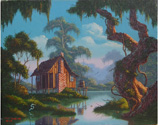
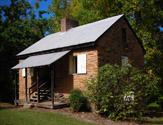









Magnolia Eden
The Catalpa Tree
More Than Just an Angler's Delight
More Than Just an Angler's Delight
Commonly known as the catalpa or Catawba tree, Catalpa bignonioides was once a popular fixture in some southern landscapes, but it is no longer widely sought after by today's gardeners and landscape specialists who prefer showier specimens such as japanese maples, dogwoods, magnolias, ornamental fruit trees and dwarf conifers.
Native to the Deep South, Catalpa bignonioides is an attractive, deciduous tree, reaching forty to forty-five feet in height. In May and June, the tree is adorned with dense clusters of white trumpet-shaped flowers marked inside with yellow stripes and lavender spots, creating a spectacular display.
Once upon a time...
Prized as an ornamental during both the colonial and antebellum periods, the catalpa was praised in a 1743 letter by famed agriculturalist Eliza Lucas (1722-1793) following her observation of the tree in William Middleton's famous garden near Charleston.
In The North American Sylva (1819), French botanist Francois André Michaux (1770-1855) wrote, "Its rapid growth, the remarkable size of its leaves, and the beauty of its numerous bunches of flowers entitle the Catalpa to a distinguished place among ornamental trees; but it has ceased to be rare, and is less highly esteemed than while it was less common."
Native to the Deep South, Catalpa bignonioides is an attractive, deciduous tree, reaching forty to forty-five feet in height. In May and June, the tree is adorned with dense clusters of white trumpet-shaped flowers marked inside with yellow stripes and lavender spots, creating a spectacular display.
Once upon a time...
Prized as an ornamental during both the colonial and antebellum periods, the catalpa was praised in a 1743 letter by famed agriculturalist Eliza Lucas (1722-1793) following her observation of the tree in William Middleton's famous garden near Charleston.
In The North American Sylva (1819), French botanist Francois André Michaux (1770-1855) wrote, "Its rapid growth, the remarkable size of its leaves, and the beauty of its numerous bunches of flowers entitle the Catalpa to a distinguished place among ornamental trees; but it has ceased to be rare, and is less highly esteemed than while it was less common."
By the late nineteenth century, the catalpa's popularity had waned. However, more than a hundred years later James R. Cothran asserts in his Gardens and Historic Plants of the Antebellum South (2003) that ". . . the catalpa remains one of the South's finest native trees, still admired for its foliage, showy flowers and decorative seed."
Hook, Line and Sinker
Though the catalpa tree is rarely desired as a centerpiece or accent in the predictable (and often lackluster) landscapes of modern-day suburbia, the tree has a faithful following among some folks who take their fishing very seriously.
The catalpa tree is the only food source for the caterpillars (larvae) of the Catalpa Sphinx moth (Ceratomia catalpae). The 2.75-2.95" caterpillars, often called catalpa worms, can appear in two color phases (dark and pale) and are highly prized by anglers as fish bait.
Catalpa Sphinx moths lay masses of white eggs on the undersides of the catalpa tree's leaves, and the resulting larvae ravenously consume the foliage. When present in sufficient numbers, the caterpillars can easily defoliate an entire tree and blanket the base of their host tree with a layer of droppings. The trees typically survive these infestations and new leaves re-emerge to feed the next crop of Ceratomia catalpae larvae. Meanwhile, the full-grown larvae pupate in the ground and emerge as adult moths about two weeks later. The final brood of the season will overwinter in the ground and emerge the following spring. Several broods can occur in a season.
The reputation of catalpa worms is known throughout the American South. Some might even insist that catalpa worms are such good fish bait that one has to hide behind a tree just to bait his hook! Some enterprising sportsmen have even planted groves of catalpa trees to meet their own fish bait needs as well as to supply catalpa worms to other fishermen who are often willing to pay a dollar or more per dozen. Many anglers also freeze the caterpillars for later use.
Production of caterpillars is subject to vary from year to year. Dr. Dale K. Pollet, an entomologist with the Louisiana State University Agricultural Center in Baton Rouge, explains, "You may have a population for three or four years and then very few for several years." A number of factors can contribute to the reduction or demise of catalpa worms. Dr. Pollet says, "Many areas where infestations were in the past have been reduced in population density due to human spread, agriculture and parasites."
Cotesia congregata is the chief culprit among more than a dozen parasitic wasps which prey on the larvae of Ceratomia catalpae. Dr. Pollet stresses, "Although the parasite is beneficial for management of other caterpillars, in catalpa worm populations they are a pest and infested caterpillars should be removed or destroyed to preserve the catalpa worm populations."
One of the small wasps deposits a single egg into the skin of a caterpillar, the egg divides several times producing 50+ larvae, and the larvae feed inside their host. Eventually, the larvae emerge to the outside. Parasitized caterpillars are easily detected by the presence of silken cocoons spun on their skin by wasp larvae during the process of pupation. Catalpa worms affected by parasitic wasps will not survive to adulthood.
Enjoy Catalpa Trees in Your Own Yard or Garden!
Catalpa trees are easily grown, adapting to a wide range of conditions. Though tolerant of sun or shade, the trees are especially suited for growing singly as a shade tree specimen.
Though not universally available, catalpa trees can be acquired from native tree and plant specialists such as the Fayetteville, Georgia-based Nearly Native Nursery, Inc. Since catalpa trees are easily propagated from seed and will grow quickly, acquiring seed is another viable option for gardeners who wish to introduce these beautiful trees into their landscapes. Seeds are available from various seed companies as well as other gardeners.
Many old homeplaces throughout the South have been graced by the presence of catalpa trees for generations, and you need not be an avid fisherman to enjoy one. As gardeners continue to reacquaint themselves with the versatility and resilience of our natives and the charm of our historic plants, perhaps trees such as the catalpa will win over new fans, reclaiming a place among the region's most beloved ornamentals.
Hook, Line and Sinker
Though the catalpa tree is rarely desired as a centerpiece or accent in the predictable (and often lackluster) landscapes of modern-day suburbia, the tree has a faithful following among some folks who take their fishing very seriously.
The catalpa tree is the only food source for the caterpillars (larvae) of the Catalpa Sphinx moth (Ceratomia catalpae). The 2.75-2.95" caterpillars, often called catalpa worms, can appear in two color phases (dark and pale) and are highly prized by anglers as fish bait.
Catalpa Sphinx moths lay masses of white eggs on the undersides of the catalpa tree's leaves, and the resulting larvae ravenously consume the foliage. When present in sufficient numbers, the caterpillars can easily defoliate an entire tree and blanket the base of their host tree with a layer of droppings. The trees typically survive these infestations and new leaves re-emerge to feed the next crop of Ceratomia catalpae larvae. Meanwhile, the full-grown larvae pupate in the ground and emerge as adult moths about two weeks later. The final brood of the season will overwinter in the ground and emerge the following spring. Several broods can occur in a season.
The reputation of catalpa worms is known throughout the American South. Some might even insist that catalpa worms are such good fish bait that one has to hide behind a tree just to bait his hook! Some enterprising sportsmen have even planted groves of catalpa trees to meet their own fish bait needs as well as to supply catalpa worms to other fishermen who are often willing to pay a dollar or more per dozen. Many anglers also freeze the caterpillars for later use.
Production of caterpillars is subject to vary from year to year. Dr. Dale K. Pollet, an entomologist with the Louisiana State University Agricultural Center in Baton Rouge, explains, "You may have a population for three or four years and then very few for several years." A number of factors can contribute to the reduction or demise of catalpa worms. Dr. Pollet says, "Many areas where infestations were in the past have been reduced in population density due to human spread, agriculture and parasites."
Cotesia congregata is the chief culprit among more than a dozen parasitic wasps which prey on the larvae of Ceratomia catalpae. Dr. Pollet stresses, "Although the parasite is beneficial for management of other caterpillars, in catalpa worm populations they are a pest and infested caterpillars should be removed or destroyed to preserve the catalpa worm populations."
One of the small wasps deposits a single egg into the skin of a caterpillar, the egg divides several times producing 50+ larvae, and the larvae feed inside their host. Eventually, the larvae emerge to the outside. Parasitized caterpillars are easily detected by the presence of silken cocoons spun on their skin by wasp larvae during the process of pupation. Catalpa worms affected by parasitic wasps will not survive to adulthood.
Enjoy Catalpa Trees in Your Own Yard or Garden!
Catalpa trees are easily grown, adapting to a wide range of conditions. Though tolerant of sun or shade, the trees are especially suited for growing singly as a shade tree specimen.
Though not universally available, catalpa trees can be acquired from native tree and plant specialists such as the Fayetteville, Georgia-based Nearly Native Nursery, Inc. Since catalpa trees are easily propagated from seed and will grow quickly, acquiring seed is another viable option for gardeners who wish to introduce these beautiful trees into their landscapes. Seeds are available from various seed companies as well as other gardeners.
Many old homeplaces throughout the South have been graced by the presence of catalpa trees for generations, and you need not be an avid fisherman to enjoy one. As gardeners continue to reacquaint themselves with the versatility and resilience of our natives and the charm of our historic plants, perhaps trees such as the catalpa will win over new fans, reclaiming a place among the region's most beloved ornamentals.
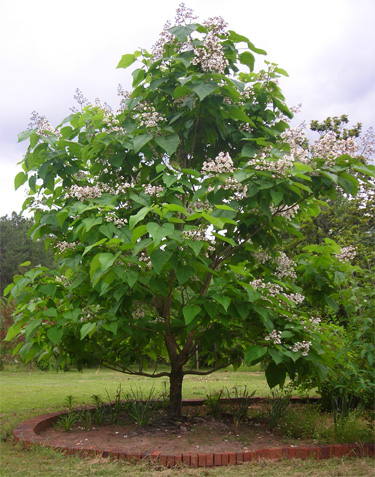
A fast grower, the catalpa tree makes a handsome stand-alone specimen or can be planted in groups or rows. Located a mile or two from the nearest catalpa trees, this tree has never been infested with catalpa worms.
(Author's Note: My brother, Junior, gave me a cup containing several 3-4" catalpa seedlings in June 2003. One of the seedlings survived several dry, oppressive summers to result in the beautiful tree in the photograph above.)
(Author's Note: My brother, Junior, gave me a cup containing several 3-4" catalpa seedlings in June 2003. One of the seedlings survived several dry, oppressive summers to result in the beautiful tree in the photograph above.)
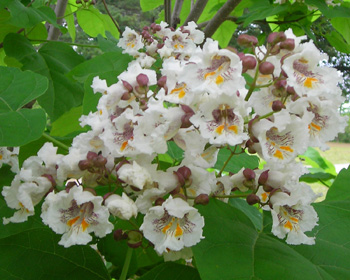
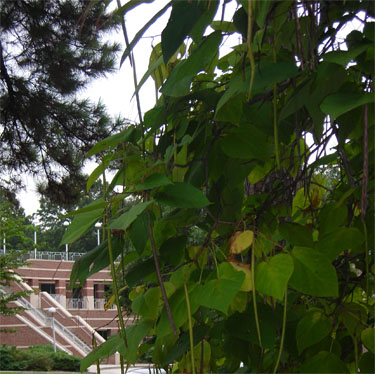
This catalpa tree was located beside Clemson University's Strom Thurmond Institute at the time this article first appeared, but has since been removed due to a construction project. Likened to cigars, the seed capsules add interest to the catalpa tree in late summer and remain on the tree after the leaves have dropped for the fall. No catalpa worms were present on this tree at the time of this photograph.
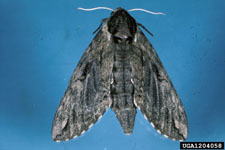
Lacy L. Hyche, Auburn University, Bugwood.org
An adult Catalpa Sphinx moth (Ceratomia catalpae)
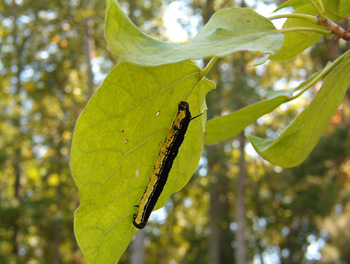
The larvae of the Catalpa Sphinx moth, often called catalpa worms, generally appear in two color phases. Pictured here is a dark phase larva. Note the characteristic horn or spine on its back at the rear.
(FREE SEED: The author is willing to share seed from his own Catalpa bignonioides tree. Click here to request your seeds.)
BIBLIOGRAPHY
James R. Cothran, Gardens and Historic Plants of the Antebellum South (Columbia: University of South Carolina Press, 2003).
John Eastman, The Book of Field and Roadside Open-Country Weeds, Trees and Wildflowers of Eastern North America (Mechanicsburg, Pennsylvania: Stackpole Books, 2003).
Francois André Michaux, The North American Sylva (Paris: C. D.'Hautel, 1819).
Robert T. Mitchell and Herbert S. Zim, Butterflies and Moths: A Guide to the More Common American Species (New York: Golden Press, 1964).
OTHER SOURCES
Electronic mail communication with Dr. Dale K. Pollet, Louisiana State University, John M. Parker Agricultural Center, Baton Rouge, on August 19, 2009
James R. Cothran, Gardens and Historic Plants of the Antebellum South (Columbia: University of South Carolina Press, 2003).
John Eastman, The Book of Field and Roadside Open-Country Weeds, Trees and Wildflowers of Eastern North America (Mechanicsburg, Pennsylvania: Stackpole Books, 2003).
Francois André Michaux, The North American Sylva (Paris: C. D.'Hautel, 1819).
Robert T. Mitchell and Herbert S. Zim, Butterflies and Moths: A Guide to the More Common American Species (New York: Golden Press, 1964).
OTHER SOURCES
Electronic mail communication with Dr. Dale K. Pollet, Louisiana State University, John M. Parker Agricultural Center, Baton Rouge, on August 19, 2009
Author: Greg Freeman. Published September 10, 2009.
Copyright
Southern Edition
All Rights Reserved
Southern Edition
All Rights Reserved
All materials contained on this site, including text and images, are protected by copyright laws and may not be reproduced without prior written permission from the publisher. Where applicable, use of some items contained on this site may require permission from other copyright owners.
Fair Use of text from SouthernEdition.com is permitted to the extent allowed by copyright law. Proper citation is requested. Please use this guide when citing a Southern Edition article.
Contact Greg Freeman or SouthernEdition.comFair Use of text from SouthernEdition.com is permitted to the extent allowed by copyright law. Proper citation is requested. Please use this guide when citing a Southern Edition article.